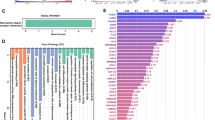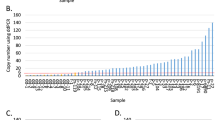Abstract
Chromosome 11q13 is amplified in about 13% of primary breast cancers. CCND1, encoding the cell cycle regulatory gene cyclin D1, and EMS1, encoding a filamentous actin binding protein, are favoured candidate onocogenes, whereas INT-2 is an unexpressed gene at this locus. In this study we tested the possibility that different regions of this large amplicon could be independently amplified and subsequently defined the phenotype of EMS1 amplified tumours in a series of 961 primary breast carcinomas. Using DNA slot blots, EMS1 was amplified in 15.2% of samples: 5.4% were coamplified for CCND1; 7.9% coamplified for INT-2 and 6.7% showed EMS1 amplification alone. The degree of amplification of CCND1 and INT-2 was highly correlated (P=0.0001). In contrast, no such relationship existed between EMS1 and CCND1 or INT-2 amplification, demonstrating independent amplification of EMS1 in 44% of amplified tumours. EMS1 amplification (⩾twofold increase in copy number) was positively correlated with patient age ⩾50 years (P=0.025), ER positivity (P=0.022), PgR positivity (P=0.018), and was negatively correlated with HER-2/neu (c-erbB2) amplification (P=0.01). In common with CCND1/INT-2, EMS1 amplification was associated with increased risk of relapse in patients with lymph node-negative disease (P=0.028). In contrast, EMS1 and CCND1/INT-2 amplification appeared to confer different phenotypes in ER positive and negative tumours. A ⩾threefold increase in EMS1 copy number was associated with an apparent increased risk of relapse and death in patients with ER negative tumours, but was without effect in ER positive tumours. In contrast, CCND1/INT-2 amplification had no effect in the patients with ER negative tumours but was associated with early relapse in ER positive patients. Thus EMS1 amplification may identify subgroups of breast cancer patients with increased probability of relapse and death distinct from those identified by CCND1/INT-2 amplification. Further studies are required to more clearly determine the functional consequences of EMS1 overexpression and a biological basis for the relationship between EMS1 amplification and phenotype in breast cancer.
This is a preview of subscription content, access via your institution
Access options
Subscribe to this journal
Receive 50 print issues and online access
$259.00 per year
only $5.18 per issue
Buy this article
- Purchase on Springer Link
- Instant access to full article PDF
Prices may be subject to local taxes which are calculated during checkout
Similar content being viewed by others
Author information
Authors and Affiliations
Rights and permissions
About this article
Cite this article
Hui, R., Campbell, D., Lee, C. et al. EMS1 amplification can occur independently of CCND1 or INT-2 amplification at 11q13 and may identify different phenotypes in primary breast cancer. Oncogene 15, 1617–1623 (1997). https://doi.org/10.1038/sj.onc.1201311
Received:
Revised:
Accepted:
Issue Date:
DOI: https://doi.org/10.1038/sj.onc.1201311
Keywords
This article is cited by
-
A novel Pyk2-derived peptide inhibits invadopodia-mediated breast cancer metastasis
Oncogene (2023)
-
Aberrant Cyclin D1 splicing in cancer: from molecular mechanism to therapeutic modulation
Cell Death & Disease (2023)
-
LIMK2 promotes melanoma tumor growth and metastasis through G3BP1-ESM1 pathway-mediated apoptosis inhibition
Oncogene (2023)
-
Disease characterization in liquid biopsy from HER2-mutated, non-amplified metastatic breast cancer patients treated with neratinib
npj Breast Cancer (2022)
-
Wnt5a induces ROR1 to recruit cortactin to promote breast-cancer migration and metastasis
npj Breast Cancer (2019)



